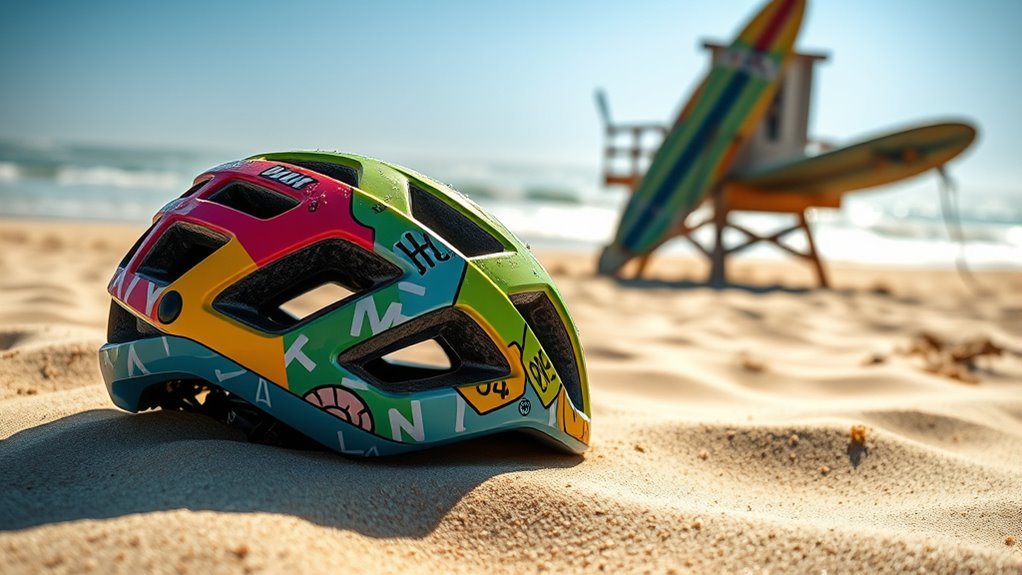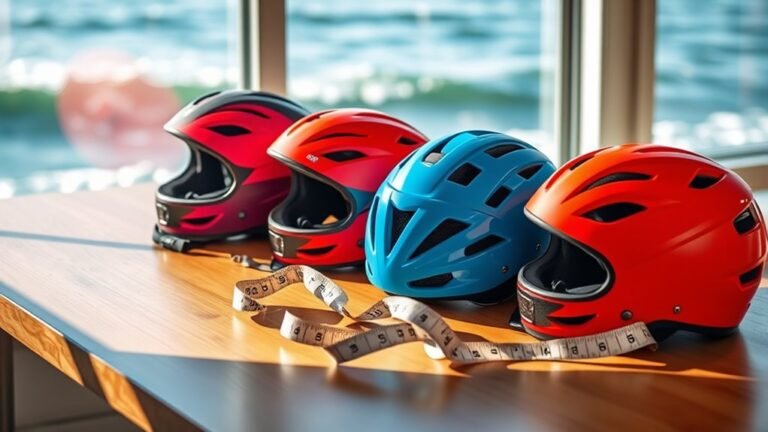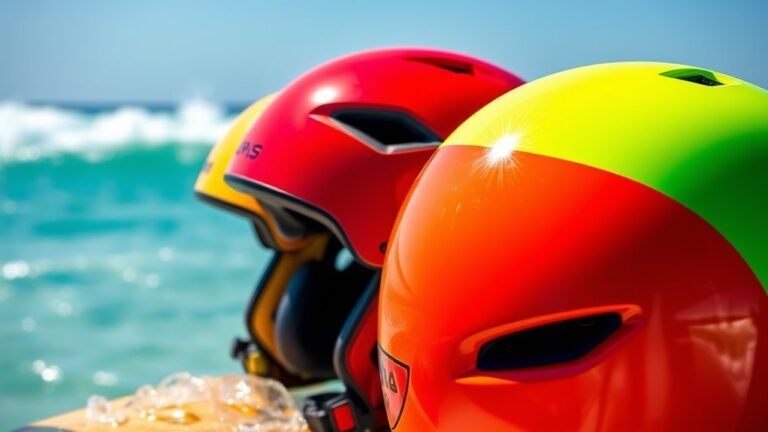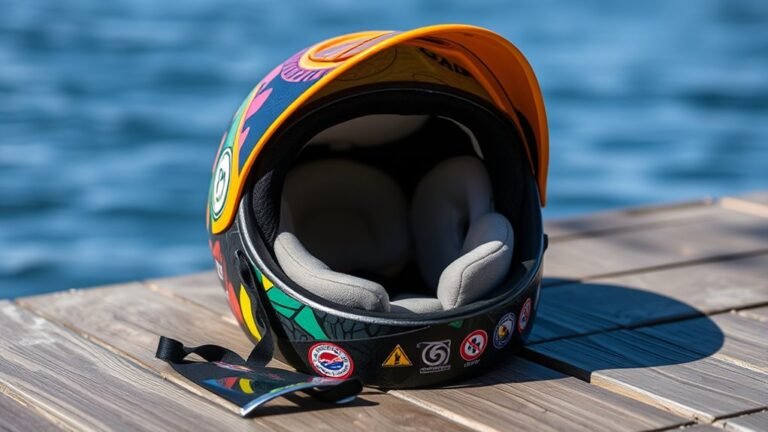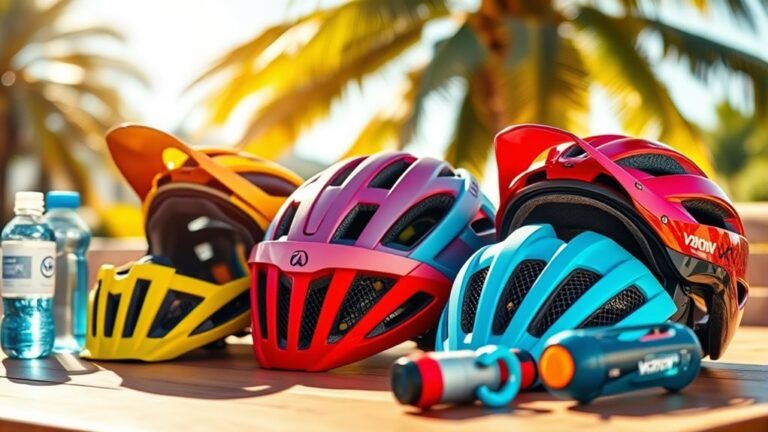Can You Use a Bike Helmet for Water Sports?
You shouldn’t use a bike helmet for water sports. Bike helmets lack the necessary buoyancy and specific safety standards required for aquatic activities. They also may not handle impacts from waves effectively and can accumulate water, increasing risk. Specialized water sport helmets are designed for these conditions, ensuring better protection and performance. If you want to know more about why choosing the right helmet matters, there’s more information available on the topic.
Understanding Bike Helmets
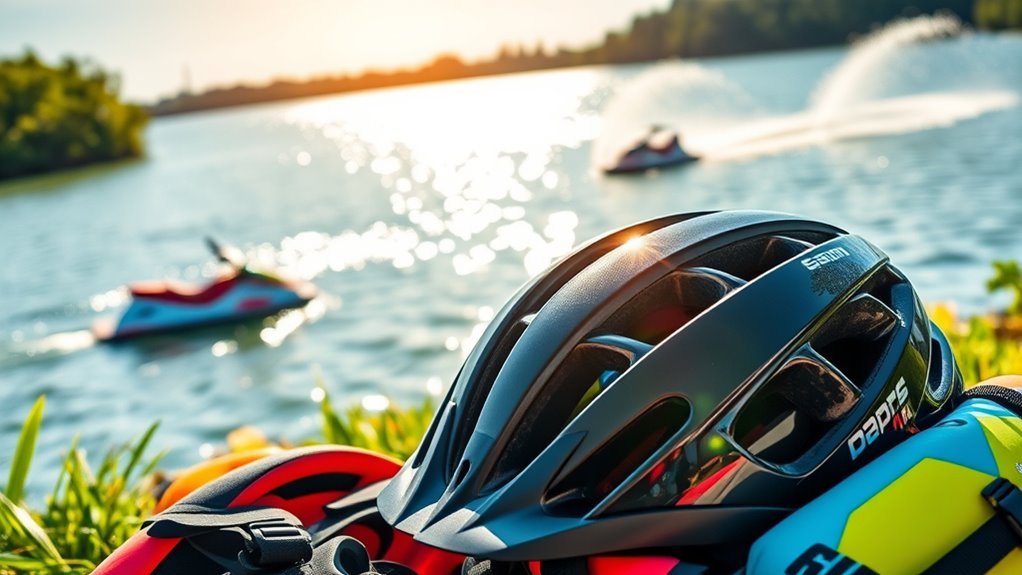
When it comes to safety gear, understanding bike helmets is vital, especially if you’re considering using one for water sports. Bike helmets are crafted from various helmet materials like expanded polystyrene foam, which absorbs impact, and polycarbonate shells that provide durability. You’ll want to guarantee that any helmet you choose meets recognized safety standards, such as CPSC or ASTM, designed to protect your head in the event of a fall or collision. While a bike helmet can offer some level of protection, it’s important to recognize that water sports environments pose unique risks. The helmet’s design, ventilation, and buoyancy may not suffice for activities like kayaking or wakeboarding. Always prioritize your safety and choose equipment tailored specifically for the sport you’re engaging in.
The Importance of Water Sport Helmets
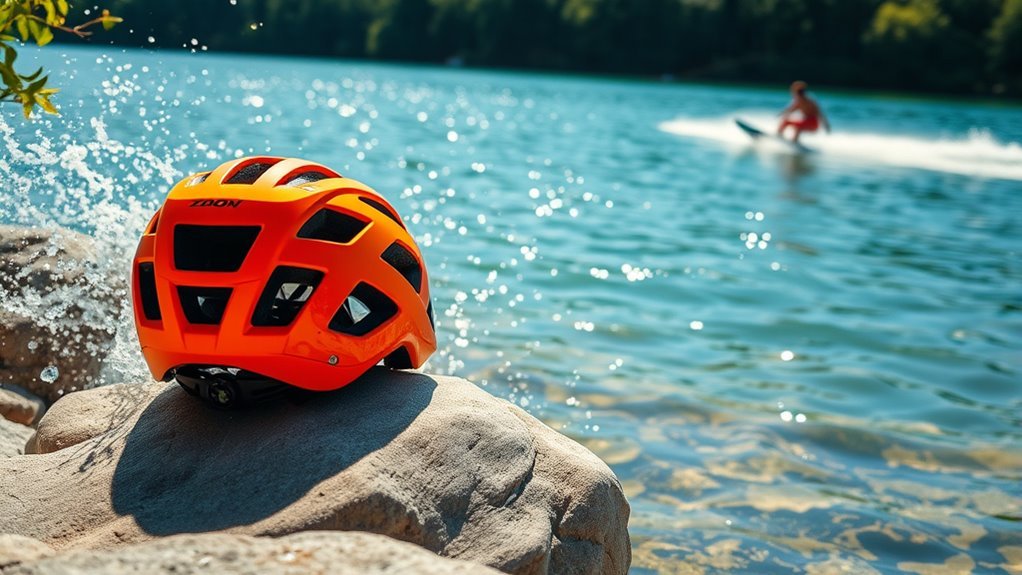
While you might think a bike helmet could suffice for water sports, specialized helmets are vital for guaranteeing your safety in aquatic environments. Water sport helmets are designed to withstand impacts from waves, falls, and collisions that can occur while you’re surfing, kayaking, or wakeboarding. They provide better flotation and ventilation compared to bike helmets, which is important for water safety. Following helmet guidelines specific to water activities guarantees you’re protected from potential injuries. Remember, the right helmet can make a significant difference in your experience on the water. Choosing a helmet designed for your chosen sport isn’t just about safety; it’s about enjoying your freedom on the water with confidence. Prioritize your protection and choose wisely!
Key Differences Between Bike and Water Sport Helmets
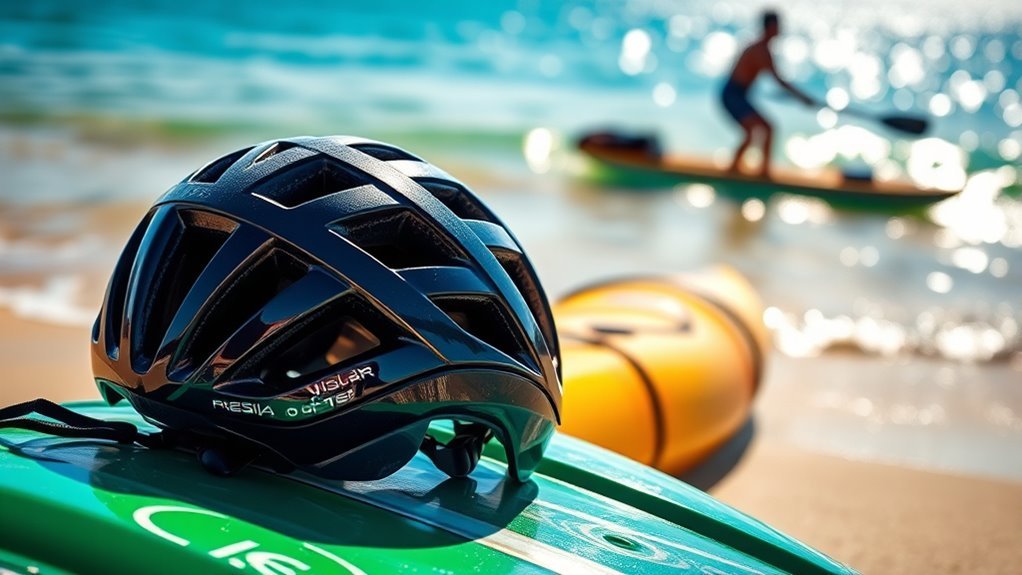
When it comes to helmets, the design and structure vary greatly between bike and water sport options. Bike helmets prioritize ventilation and aerodynamics, while water sport helmets are built to handle impacts in aquatic environments. Understanding these differences in impact resistance levels is essential for your safety in each activity.
Design and Structure
Choosing the right helmet for your sport can greatly impact safety and performance. When considering bike versus water sport helmets, you’ll notice key differences in design and structure. Here are some important factors to keep in mind:
- Aerodynamic Features: Bike helmets are designed for airflow, reducing drag while cycling, whereas water helmets prioritize a streamlined shape for minimal resistance in water.
- Buoyancy Considerations: Water sport helmets often incorporate buoyant materials to help keep your head above water.
- Ventilation: Bike helmets have numerous vents for airflow; water helmets may have fewer to maintain structural integrity.
- Padding: Water helmets typically use water-resistant padding, while bike helmets use moisture-wicking materials.
Understanding these differences helps guarantee you choose the right helmet for your adventures.
Impact Resistance Levels
Impact resistance is a crucial factor in helmet safety, especially when comparing bike and water sport helmets. While both types aim to protect you, their impact absorption capabilities differ greatly due to varying safety standards.
| Helmet Type | Impact Absorption | Safety Standards |
|---|---|---|
| Bike Helmet | Moderate | CPSC, EN 1078 |
| Water Sport Helmet | High | ASTM F2040 |
| Dual-Sport Helmet | Variable | Depends on Design |
Bike helmets focus on reducing injuries from falls on hard surfaces, whereas water sport helmets are crafted to withstand higher forces associated with water impacts. When choosing, consider the specific risks of your activity to guarantee maximum protection. Your freedom on the water or road depends on your safety gear!
Pros of Using a Bike Helmet for Water Activities
Using a bike helmet for water activities offers several advantages. First, it provides essential protection against impact, which is vital during falls or collisions. Additionally, these helmets are lightweight and comfortable, making them versatile for various water sports.
Protection Against Impact
When it comes to water activities, having the right protective gear can make a significant difference, and a bike helmet offers valuable impact protection. While it’s designed for cycling, it can absorb impact forces effectively, helping reduce the risk of head injuries during water sports. Here are some advantages of using a bike helmet for impact protection:
- Robust construction – Bike helmets meet safety standards for impact resistance.
- Cushioning – The inner foam padding provides shock absorption.
- Coverage – Helmets offer extensive protection for the head.
- Versatility – You can use it for various activities, from surfing to kayaking.
While not specifically designed for water, a bike helmet can still offer essential protection against unexpected falls or collisions.
Lightweight and Comfortable
A bike helmet’s lightweight design makes it a comfortable choice for water activities, allowing you to focus on your performance without feeling weighed down. These helmets are often crafted from lightweight materials, ensuring they won’t hinder your movement as you paddle, surf, or kayak. The comfortable fit of a bike helmet is another advantage, as it can be easily adjusted to suit your head shape, providing stability during your adventures. Unlike bulkier water sports helmets, a bike helmet lets you enjoy the thrill of your chosen activity without discomfort. This freedom of movement enhances your experience, making every moment on the water more enjoyable. So, if you’re looking for a balance of comfort and performance, consider a bike helmet for your next outing.
Versatile for Activities
Though many might not consider a bike helmet for water sports, its versatility makes it an excellent choice for various activities. This multi sport versatility allows you to adapt seamlessly to different environments. Here are some benefits you should consider:
- Water Safety: Protects your head during unexpected falls.
- Activity Adaptability: Great for kayaking, paddleboarding, and jet skiing.
- Durability: Engineered to withstand impacts, making it reliable for rough conditions.
- Cost-Effective: One helmet serves multiple purposes, saving you money on specialized gear.
Cons of Using a Bike Helmet for Water Activities
While bike helmets are designed to protect your head during cycling, they may not provide adequate safety for water sports. One major concern is that bike helmets don’t meet the specific safety standards required for aquatic activities. Water conditions can vary greatly, and helmets not designed for those environments might not withstand impacts or provide proper flotation. Additionally, they often lack features like drainage holes, which can lead to water accumulation, increasing weight and risk during a fall. The materials used in bike helmets may also degrade when exposed to saltwater or chlorine, compromising their integrity. For your safety, it’s essential to use a helmet specifically designed for the water, ensuring it meets the necessary safety standards for a secure ride.
Legal Requirements for Helmet Use in Water Sports
When participating in water sports, understanding the legal requirements for helmet use is crucial for your safety and compliance. Different jurisdictions have varying legal regulations that dictate when and how helmets should be worn. Here are some key points to reflect on:
- State Laws: Some states require helmets for specific water sports, like jet skiing or kayaking.
- Age Restrictions: Many regions enforce helmet use for minors, guaranteeing they meet safety standards.
- Activity Type: Laws may differ based on the water activity, such as wakeboarding versus paddleboarding.
- Enforcement: Non-compliance can lead to fines or penalties, impacting your freedom to enjoy water sports.
Always check local regulations to verify you’re following safety standards and protecting yourself while having fun.
Recommendations for Safe Water Sports Gear
Ensuring you have the right gear for water sports is essential not only for your enjoyment but also for your safety. Always prioritize equipment that meets safety standards specific to the activity you’re participating in. Whether you’re kayaking, wakeboarding, or paddleboarding, each sport requires gear designed for peak performance and protection.
Make sure your gear is compatible with other equipment you plan to use, like life jackets or wetsuits. For instance, a buoyancy aid may be more appropriate than a bike helmet when engaging in water activities. Don’t compromise on safety for style—invest in high-quality, specialized gear. This way, you can fully embrace the freedom water sports offer, knowing you’re well protected while you enjoy the waves.
Making an Informed Decision on Helmet Use
Choosing the right helmet for water sports can greatly impact your safety and performance. It’s vital to understand that not all helmets are created equal. To make an informed decision, consider these key factors:
- Material: Look for helmets made from water-resistant materials to enhance durability.
- Certification: Verify the helmet meets safety standards specific to water sports.
- Fit: A snug, comfortable fit is essential for helmet safety; it should not move during activity.
- Ventilation: Good airflow can prevent overheating, especially in warm conditions.
Frequently Asked Questions
Can a Bike Helmet Float in Water?
No, a bike helmet won’t float in water like a superhero in a cape! When it comes to buoyancy testing, these helmets aren’t designed for that. They’re built to absorb impact, not to keep you bobbing on the surface. Safety regulations for biking and water sports differ, so using a bike helmet in water isn’t just impractical; it’s potentially dangerous. Stick to helmets specifically made for water activities to guarantee your safety!
How Do Bike Helmets Handle Impact in Water?
Bike helmets aren’t designed for impact resistance in water. They’re built for cycling, focusing on protecting against falls and collisions on land. When submerged, they may not provide the necessary cushioning for water-related impacts, compromising your water safety. If you’re engaging in water sports, it’s crucial to use a helmet specifically designed for aquatic environments. This guarantees you’re adequately protected while enjoying your freedom in the water. Stay safe and choose wisely!
Are Bike Helmets Adjustable for Different Head Sizes?
Yes, bike helmets are typically adjustable for different head sizes. They often come with adjustable straps and a dial or a simple mechanism that lets you customize the fit based on your head circumference. This guarantees a snug and secure fit, enhancing both comfort and safety. When you find the right adjustment, you’ll feel more confident and free to enjoy your ride without worrying about your helmet shifting or coming loose.
Can I Wear a Bike Helmet While Kayaking?
You can wear a bike helmet while kayaking, but it’s not ideal for kayak safety. Bike helmets aren’t designed for water impact and don’t provide the same protection as a water sports helmet. Plus, if it doesn’t fit snugly, it could slip off in the water. For the best experience and safety, invest in a helmet specifically made for kayaking. Stay safe, and enjoy your freedom on the water!
Do Bike Helmets Provide UV Protection for Water Sports?
Bike helmets typically don’t provide adequate UV protection for water exposure. They’re designed mainly for impact absorption and not for shielding against harmful rays. While you might feel safe on the water, you’re still risking sun damage without proper UV protection. If you’re spending time under the sun, it’s better to wear a hat or a helmet specifically designed for water sports, which can offer both safety and sun protection. Stay smart and protected!
